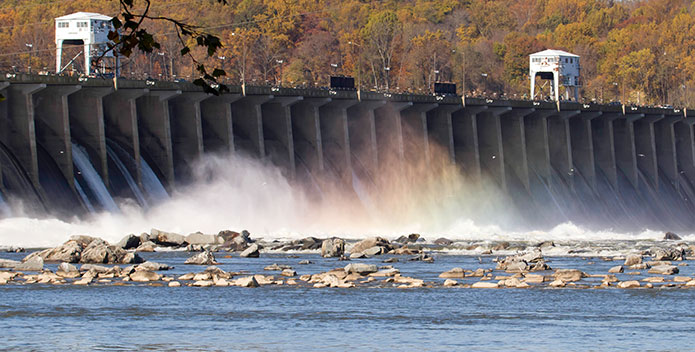The following first appeared in, The Chestertown Spy.
The Conowingo Dam 20 miles north of the mouth of the Susquehanna River has been the focus of scientific scrutiny and concern since the 1990s, and public worry for the past five years. The reason is simple: the pond behind the dam that trapped dirt for decades now has filled up.
More of the dirt (also called sediment) and phosphorus clinging to the dirt are reaching downstream water. In addition, storms scour sediment and associated nutrients from the pond and flush it downstream.
These additional pollutant loads are a problem because we already have too much phosphorus and nitrogen in the Chesapeake Bay–from farms, sewage plants, and other sources. These chemicals are plant food, causing algae blooms that suck oxygen from the water when they die and decompose. The added sediment coming through the dam also is a concern for effects on downstream habitats.
When Bay states and the federal government agreed in 2010 to reduce pollution in the Chesapeake—the so-called Bay pollution diet—they thought we had more time to deal with the situation at the Conowingo. We don't. What to do?
In 2015 the U.S. Army Corps said the most cost-effective solution was to reduce pollution reaching the dam from upstream in Pennsylvania and New York. Governor Hogan has also proposed a small $4 million pilot program to see if dredging at the pond could also be a part of the solution.
Whatever is determined to be the best solution or set of solutions, one thing is clear: it will cost more money. That's why a new report commissioned by the Chesapeake Bay Foundation (CBF) and The Nature Conservancy (TNC) offers some good news: The owner of the dam can help chip in.
The report, "An Economic Analysis of the Conowingo Hydroelectric Generating Station," concluded Exelon can afford to contribute $27 million to $44 million a year to help fix or mitigate the problem and still make a healthy profit. The study used publicly available finance numbers about Exelon's operations at the dam, as well as standard industry information. It was prepared for Water Power Law Group, CBF, and TNC but researched and written by Energy+Environmental Economics in California. Exelon to date has offered to contribute only $200,000.
The company shouldn't be responsible for the whole solution. It didn't cause pollution from upstream farms, sewage plants, and other sources to discharge into the Susquehanna and flow downstream.
While it is important to hold Exelon accountable for the impact of the dam on downstream water quality and habitat, it's important to keep the Conowingo issue in context. First, the impacts of the lost trapping capacity and scouring during storm events are significant but not catastrophic. In fact, as the situation at the dam has worsened for the past few years, the water quality in the Bay has steadily been improving.
Also, studies show that the slug of new pollution moving past the dam will cause effects primarily on the mainstem of the Chesapeake Bay. Most rivers that feed the Bay such as the Choptank, Nanticoke and others will not be impacted, nor will the thousands of fresh water streams in Maryland. Local counties and communities will remain responsible for cleaning up pollution in their backyards.
So, we can't blame Conowingo for all our water woes. The dam is only one of many problems we face trying to clean up the Bay. But we can ask Exelon to do its share, just as we ask everyone else to pitch in. We know the company can afford it.
Tom Zolper
Issues in this Post
Runoff Pollution
Chesapeake Clean Water Blueprint Conowingo Dam and
Chesapeake Bay Runoff Pollution The Susquehanna River Water Quality
CBF in Maryland



